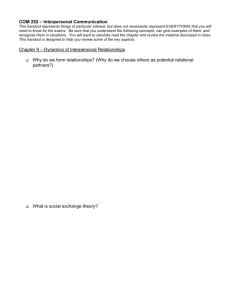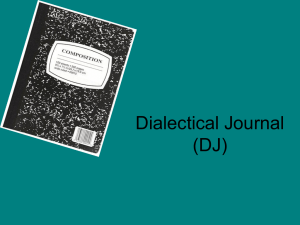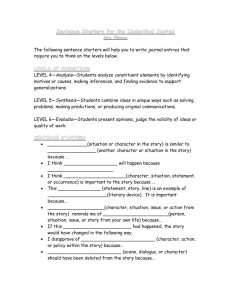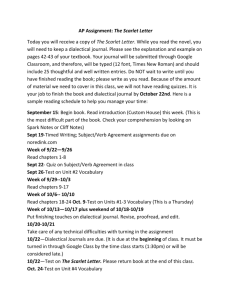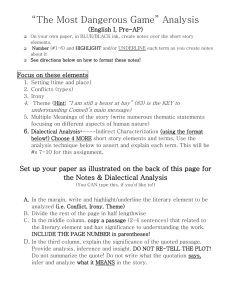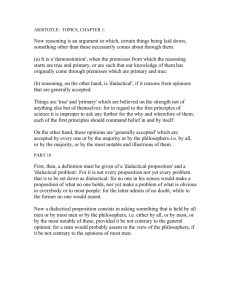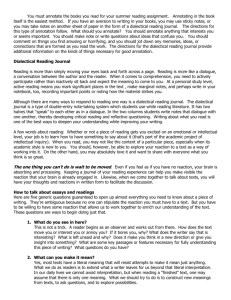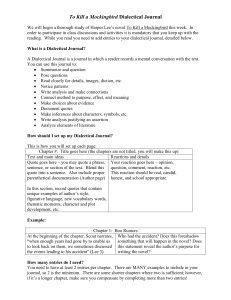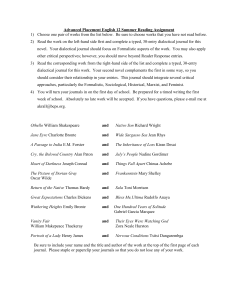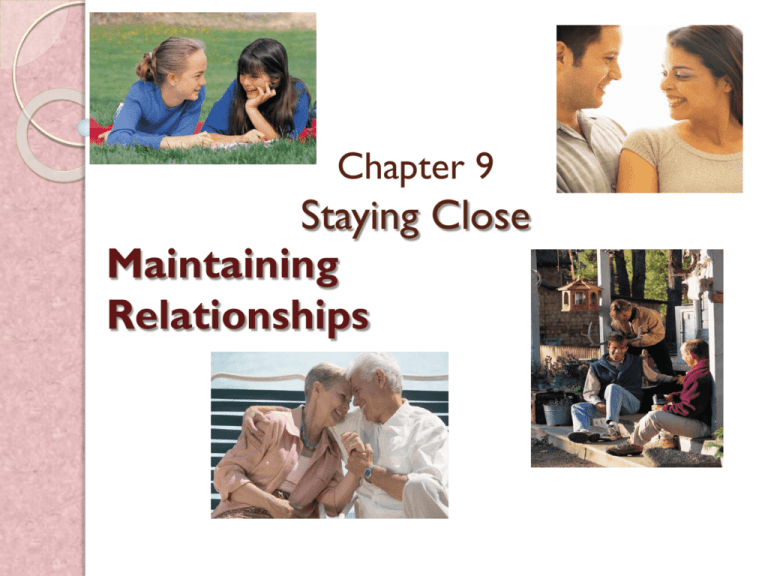
Chapter 9
Staying Close
Maintaining
Relationships
Activate your Brain
What does it mean to maintain a relationship?
Which of these statements is true?
◦ Relationships stay together unless
something tears them apart.
◦ Relationships require effort or else they fall
apart.
What is the most important aspect of
maintaining a romantic relationship?
What is the most important aspect of
maintaining a friendship?
Why do approximately 50% of marriages in
the US end in divorce?
Defining Relational Maintenance
Relational Maintenance: Four common definitions
keeping a relationship in existence
keeping a relationship in a specified state or
condition
keeping a relationship in satisfactory condition
keeping a relationship in repair (prevent and repair
problems)
Basically, “keeping a relationship at a desired level”
(e.g., professional, or casual friend, or romantic)
Maintenance can be strategic or routine (pp. 212213)
Two Overarching Perspectives
Centrifugal Perspective:
◦ Relationships require
maintenance or else
they deteriorate
Centripetal Perspective:
◦ Established relationships
are automatically maintained
unless something tears them apart
Box 9.3, p. 215
Prosocial Maintenance Behaviors
Stafford & Canary (Married & Dating Couples)
o Positivity:
o Making interactions pleasant and enjoyable
o Openness:
o Self-disclosure, sharing secrets, and routine talk
o Assurances:
o Giving each other assurances about commitment
o Social Networking:
o Spending time with each other’s social network
o Task Sharing:
o Performing routine tasks and
o chores relationship together
Additional Maintenance Behaviors
o Supportiveness:
o Giving social support and encouragement
o Joint Activities:
o Engaging in activities and spending time together
o Romance and Affection:
o Revealing positive, caring feelings for each other
o Humor:
o Using inside jokes and other forms of humor
o Constructive Conflict Management:
o Promote problem-solving and harmony
Antisocial Maintenance Behaviors
From Box 9.2 (p. 210)
oAvoidance
oNo flirting
oTalking about others (esp. a partner)
oJealousy induction
oSpying
oInfidelity
oAllowing control
oDestructive conflict
In sum-
Prosocial Maintenance Behaviors..
predict whether couples stay together or break up.
are positively associated with relational satisfaction and
commitment (especially positivity, assurances, & social
networking).
Antisocial Maintenance Behaviors
Manipulative and controlling
Why would a partner ever use these behaviors?
They decrease satisfaction and even sometimes lead to
termination
When used as “maintenance” they are attempts to control the
partner (prevent breaking up), make partner see you as more
desirable, to avoid conflict, or keep relationship at “desired level”
of intimacy or closeness.
Modality of Maintenance Behavior
Modality = channel of communication
◦ Face-to-face or mediated
◦ Some maintenance behaviors can be done in both
modalities but others cannot (e.g., task sharing such
as working on a paper together vs. doing dishes)
◦ Facebook users tend to send messages of assurance
and positivity
◦ Close friends and romantic partners need more than
just Facebook to maintain intimacy.
Maintenance Behaviors in Online
Relationships
Wright (2004)—openness and positivity most
frequently used
Types of relationships (Rabby, 2007)
◦
◦
◦
◦
Virtual relationships
Pinocchio relationship
Cyber emigrant relationships
Real world relationships
Virtual-only group least maintenance behavior
unless highly committed
How do we end a relationship in a social
networking site?
Maintenance Behaviors in Romantic
Relationships
Openness, assurances, and positivity seem to be
most common
However, patterns change overtime:
◦ As become more committed, may provide more
assurances, share more tasks, and integrate social
networks
◦ Dating, more mediated communication
◦ Openness and positivity may peak before full
commitment (marriage)
◦ Once married, maintenance
may be curvilinear
Maintenance in Same-Sex Friendships
Girls value communication—talking (35% of 10-17 yearold girls said giving up telephone most difficult).
Boys value engaging in activity—doing (only 6.5% said
giving up telephone would be most difficult)
The “doing” versus “talking” distinction extends to adult
friendships of men and women.
However, differences in men’s & women’s friendships not
that dramatic; more similarity than difference.
Challenges in Maintaining Cross-Sex
Friendships
Emotional Bond Challenge
◦ People are socialized to see members of the opposite
sex as romantic partners
◦ Feelings of closeness can be
confused with romance
Sexual Challenge
◦ Sexual attraction
◦ One or both may desire a sexual
relationship
Public Presentation Challenge
◦ Having to “explain” the friendship
◦ Jealousy from romantic partners
Maintenance in Cross-Sex Friendships
with Romantic Intent
Strictly Platonic
◦ Less joint activity & flirtation, but more talk about outside
relationships
Mutual Romance
◦ Most maintenance behavior
Desires Romance (Partner doesn’t want romance)
◦ High level of maintenance but least likely to talk about the
relationship
Rejects Romance (Partner wants romance)
o
Less joint activity & flirtation, but more talk about outside
relationships
Reasons for Keeping a Cross-Sex
Friendship Platonic
safeguarding the relationship
◦ most common
not attracted
network disapproval
third party relationship
risk aversion
time out
Maintaining “Friends with Benefits”
Relationship
48%-68% of college students have had at least one friendswith-benefits relationship.
Advantages: sex with trusted other but no commitment
Disadvantages: fear of romantic feelings (or hurt)
Maintaining FWB relationships includes rules to regulate:
◦ emotional attachment
no jealousy
◦ sexual activity
◦ communication
◦ secrecy
◦ permanence/sex temporary
◦ value of the friendship
Women value friends, men value benefits
Maintenance in Long-Distance
Relationships
Between 25% to 40% of college students’ romantic
relationships are long-distance (2001).
Despite less face-to-face communication, many LDRs
are satisfying (and partners report strong love), in part
because:
◦ Idealization
partners can control the communication
partners often on their “best behavior” when
together
prepare for time together
The Dialectical Perspective
Relationships are dynamic rather than
static entities.
In healthy relationships people adapt to
one another’s changing needs by
managing dialectical tensions.
Dialectical Tensions
People experience dialectical tension
when they want to fulfill seemingly
contradictory needs
Dialectical tensions have both internal
and external manifestations
Internal: interaction within the
relational dyad
External: how the couple interacts
with people outside of the dyad
Baxter’s Typology of Dialectical Tensions
IntegrationSeparation
Internal
ConnectionAutonomy
External
InclusionSeclusion
StabilityChange
Predictability
-Novelty
ExpressionPrivacy
OpennessClosedness
Conventionality Revelation- Uniqueness
Concealment
Dialectic of
Integration-Separation
Connection-Autonomy: Individuals want
to be close to their partners, but they also
want personal freedom
Inclusion-Seclusion: Couples want to spend
time with their social network but they also
want time alone
Dialectic of
Stability-Change
Predictability-Novelty: Individuals want
routine and consistency in their
relationships/partners, but also want
spontaneity and novelty.
Conventionality-Uniqueness: Couples
want to adhere to social norms to fit in
with others, but they also want to see
themselves as special and unique.
Dialectic of
Expression-Privacy
Openness-Closedness: Individuals want to
feel free to self-disclose but also to keep
some secrets.
Revelation-Concealment: Couples want
to talk about their relationships with their
social networks, but they also want to keep
some aspects of their relationships private.
Managing Dialectical Tensions
Selection: Deciding to value one side of the
dialectic more than the other
Separation: Favoring different sides of the
dialectic at different times
◦ Cyclic Alternation: cycling back and forth between
the two sides
◦ Topical Segmentation: emphasizing different sides of
the dialectic based on topic or context
Managing Dialectical Tensions,
cont.
Neutralization: avoiding full engagement of either
side of the dialectic
• Moderation: striving to reach a midpoint
• Disqualification: striving to be ambiguous so
neither side of the dialectic is engaged
Reframing: adjusting perceptions so that the
dialectics are viewed as complementary rather than
contradictory
Probably the best strategy overall
Rawlins’ Dialectical Tensions in
Friendships
independent-dependent
expressive-protection
judgment-acceptance
affection-instrumentality
public-private
ideal-real

